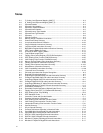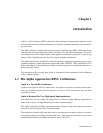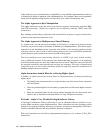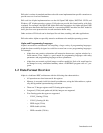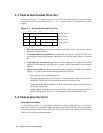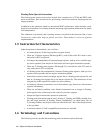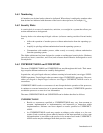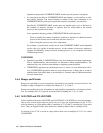1–2 Alpha Architecture Handbook
Alpha makes it easy to maintain binary compatibility across multiple implementations and easy
to maintain full speed on multiple-issue implementations. For example, there are no implemen-
tation-specific pipeline timing hazards, no load-delay slots, and no branch-delay slots.
The Alpha Approach to Byte Manipulation
The Alpha architecture reads and writes bytes between registers and memory with the LDBU
and STB instructions. (Alpha also supports word read/writes with the LDWU and STW
instructions.)
Byte shifting and masking is performed with normal 64-bit register-to-register instructions,
crafted to keep instruction sequences short.
The Alpha Approach to Multiprocessor Shared Memory
As viewed from a second processor (including an I/O device), a sequence of reads and writes
issued by one processor may be arbitrarily reordered by an implementation. This allows imple-
mentations to use multibank caches, bypassed write buffers, write merging, pipelined writes
with retry on error, and so forth. If strict ordering between two accesses must be maintained,
explicit memory barrier instructions can be inserted in the program.
The basic multiprocessor interlocking primitive is a RISC-style load_locked, modify,
store_conditional sequence. If the sequence runs without interrupt, exception, or an interfering
write from another processor, then the conditional store succeeds. Otherwise, the store fails and
the program eventually must branch back and retry the sequence. This style of interlocking
scales well with very fast caches and makes Alpha an especially attractive architecture for
building multiple-processor systems.
Alpha Instructions Include Hints for Achieving Higher Speed
A number of Alpha instructions include hints for implementations, all aimed at achieving
higher speed.
• Calculated jump instructions have a target hint that can allow much faster subroutine
calls and returns.
• There are prefetching hints for the memory system that can allow much higher cache hit
rates.
• There are granularity hints for the virtual-address mapping that can allow much more
effective use of translation lookaside buffers for large contiguous structures.
PALcode – Alpha’s Very Flexible Privileged Software Library
A Privileged Architecture Library (PALcode) is a set of subroutines that are specific to a par-
ticular Alpha operating system implementation. These subroutines provide operating-system
primitives for context switching, interrupts, exceptions, and memory management. PALcode is
similar to the BIOS libraries that are provided in personal computers.
PALcode subroutines are invoked by implementation hardware or by software CALL_PAL
instructions.





